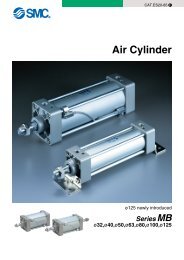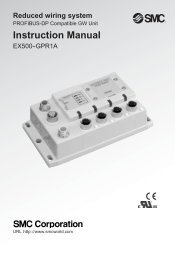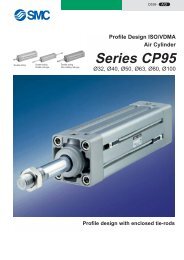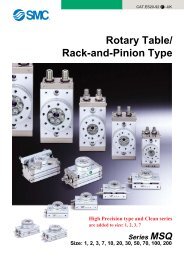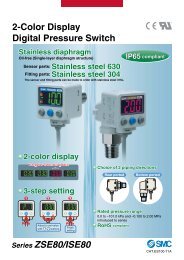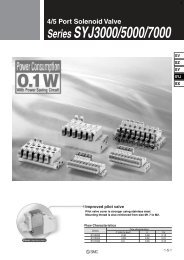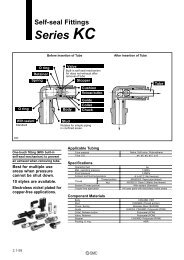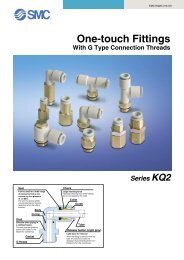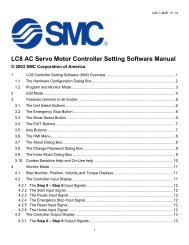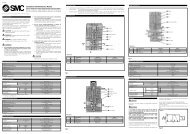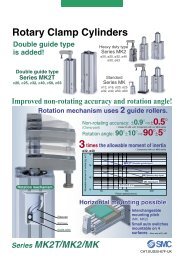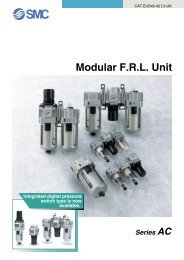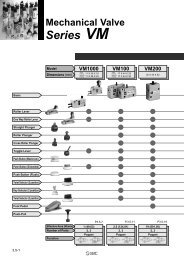ATEX_Catalogue_DKI-50185-A-U.. - SMC Pneumatics (Ireland)
ATEX_Catalogue_DKI-50185-A-U.. - SMC Pneumatics (Ireland)
ATEX_Catalogue_DKI-50185-A-U.. - SMC Pneumatics (Ireland)
- No tags were found...
You also want an ePaper? Increase the reach of your titles
YUMPU automatically turns print PDFs into web optimized ePapers that Google loves.
<strong>SMC</strong> - provide productsOutline of <strong>ATEX</strong> directiveSince 1st July 2003, equipment used in potentially explosive atmospheres withinthe EU is required to comply with the <strong>ATEX</strong> directive.<strong>ATEX</strong> directiveDirective 94/9/ECEquipment and Protective Systems intended for use in potentially Explosive Atmospheres<strong>ATEX</strong>, New Approach directives and CE markingDirective 94/9/EC, known as <strong>ATEX</strong> directive, is one of the directives based on the New Approach towards technical harmonization and standardisation.The New Approach is a new regulatory technique and strategy laid down by the European Council Resolution of 1985, in order to allow free movement ofgoods within the EU market and to prevent barriers to trade.Products in compliance with all provisions of applicable directives (such as Directive 94/9/EC for <strong>ATEX</strong>) must bear the CE marking. This is an indication thatthe products comply with the requirements of applicable directives and have been subjected to the conformity assessment procedure provided for in thesedirectives.<strong>ATEX</strong> definitionsPotentially explosive atmospheres are atmospheres likely to become explosive due to local and operational conditions.The <strong>ATEX</strong> directive regards explosive atmospheres which are defined as mixtures with air, under atmospheric conditions, of flammable substances in theform of gases, vapours, mists or dusts in which, after ignition has occurred, combustion spreads to the entire unburned mixture. (Quotation from Directive94/9/EC)The following applications are explicitly excluded by the <strong>ATEX</strong> directive and must comply with other specific standards: medical devices, equipment or safetydevices to be used with explosive or chemically unstable substances, equipment for domestic and non-commercial environments with explosive atmospheregenerated by leakage of fuel gas, personal protective equipment, offshore vessels, mobile units and means of transport.Certified equipment is designed to prevent the generation of ignition sources as defined by the standard EN1127-1:• hot surfaces• flames and hot gases• mechanically generated sparks• electrical sparks• stray electric currents, cathodiccorrosion protection• static electricity• lightning• electromagnetic fields• electromagnetic radiations• ionising radiations• ultrasonics• adiabatic compression shockwaves, gas flows• chemical reactionsZone 0Category 1Zone 2Category 3Zone 1Category 2ClassificationPotentially explosive environments areclassified into zones in accordance withDirective 1999/92/EC. These are:• 0, 1, 2 for gas explosive atmospheres• 20, 21, 22 for dust explosive atmospheres2The <strong>ATEX</strong> directive defines categories of equipment and protectivesystems, which can be used in the corresponding zones as per thefollowing table.ZoneGas Dust012202122Equipmentcategory123Presence of the explosiveatmosphereContinuously or for long periods>1000 hours/yearOccasionally10~1000 hours/yearRarely or for short periods



